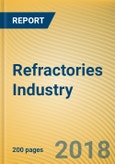In 2017, China Produced 22.9254 Million Tons of Refractories, a Year-on-Year Decrease of 4.3% (a Drop of 4.43 Percentage Points on an Annualized Basis)
As the supply-side reform is carried out over the recent years, the demand for refractories used for infrastructure projects has dived and the output of refractories keeps falling. In 2017, China produced 22.9254 million tons of refractories, a year-on-year decrease of 4.3% (a drop of 4.43 percentage points on an annualized basis).
The fall in output is because refractories for infrastructure construction was less needed since furnaces of some enterprises with substandard environmental work were forced to stop production whilst environmental protection campaign is being staged across China. The narrowed decline benefited from the recovery of downstream sectors like steel and building materials. It is expected that, in the next five years, the refractory market will witness moderate growth and the output of refractories will outnumber 24 million tons in 2022 in the wake of backward capacity being eliminated and the optimized structure of refractory industry.
As China tightens control on mineral resources and environmental pollution, the exploitation of raw materials such as magnesite was restricted in 2017 and the prices of magnesium refractory raw materials hiked. Thereupon, some suppliers of refractory raw materials and the refractory enterprises yielding proceeds from raw materials saw remarkable growth in profits, while refractory product enterprises are confronted with the amounting cost pressure and reap meager profits. Allured by the lucrative business, some enterprises in places like Liaoning province lifted their investments into high-purity magnesia projects in 2017.
In 2017, China’s export value of refractory raw materials and products surpassed USD3.0 billion and reached USD3.076 billion, soaring by 19.90% from a year earlier. Yet, the average price of refractory product exports surged by 11.85% year on year, putting an end to the downward mobility for two successive years; and the average export price of refractory raw materials started to fall from 2012 and dropped by 11.64% year on year in 2017.
The world-renowned giants in refractory business are represented by RHI Magnesita, Vesuvius, Imerys, Krosaki-Harima and Shinagawa, among which RHI Magnesita is grown from the merger of RHI and Magesita in 2017 and currently the largest producer of refractories around the globe, with its sales reporting EUR1.946 billion. Thus far, those companies without exception have operations in China. In 2017, RHI Magnesita garnered the revenue of EUR121 million in China, and it has already restarted its Chizhou-based company’s refractory material and mine production project in 2018.
There are more than 2,000 refractory manufacturers each with annual revenue of RMB20 million in China, and the Chinese market is in perfect competition due to low entry barrier and in consequence with low concentration. The top 10 refractory enterprises’ combined revenue occupied less than 20% of the total and the top 20 ones’ swept 25% or so in 2017, according to the data of the Association of China Refractories Industry. In the future, three to five large Chinese refractory groups with international competitiveness will emerge through mergers and acquisitions, integration of industrial chains, etc.
The report highlights the following:
- Demand and supply of refractories in global market and development in major countries;
- Policy climate, trade policy and industrial environment for refractories in China;
- Demand and supply and import & export of refractories in Chinese market, competition among enterprises, the development of refractories in key provinces, etc.;
- Markets of refractory raw materials (magnesite, bauxite, graphite, silicon carbide);
- Current development and major manufacturers of basic refractories, unshaped refractories, ceramic fiber, etc.;
- Demand for refractories from downstream sectors like steel, cement and glass;
- 12 global and 20 Chinese refractory enterprises (operation, refractory business, etc.).
*Note: The Chinese Version of this Report is Available on Request.
This product will be delivered within 3-5 business days.
Table of Contents
Samples

LOADING...
Companies Mentioned
- Beijing Lier High-temperature Materials Co., Ltd.
- Chosun Refractories)
- Haicheng Houying Trade Group Co., Ltd.
- Haicheng Magnesite Refractory General Factory
- Harbison Walker International (previously known as ANH Refractories)
- Henan Rongjin High Temperature Materials Co., Ltd.
- Imerys
- Jiangsu Sujia Group Co., Ltd.
- Krosaki Harima
- Liaoning Zhongmei Co., Ltd.
- Luyang Energy-Saving Materials Co., Ltd.
- Magnezit
- Minteq
- Morgan Advanced Materials (previously known as Morgan Crucible)
- Puyang Refractories Group Co., Ltd.
- RHI Magnesita
- Refratechnik
- Ruitai Materials Technology Co., Ltd.
- Saint-Gobain
- Shandong Luqiao New Materials Co., Ltd.
- Shandong Refractories Group Co., Ltd.
- Shanxi Xixiaoping Refractories Co., Ltd.
- Shinagawa Refractories
- Sinosteel Luoyang Institute of Refractories Research Co., Ltd.
- Sinosteel Refractory Co., Ltd.
- Tongda Refractory Technologies, Co. Ltd.
- Vesuvius
- Wugang Refractory Co., Ltd.
- Yingkou Jinlong Refractories Group Co., Ltd.
- Yingkou Qinghua Group Co., Ltd.
- Zhejiang Zili Advanced Materials Co., Ltd.
- Zhejiang Zili Corporation Limited.
- Zhengzhou Zhendong Technology Co., Ltd.
Methodology

LOADING...








